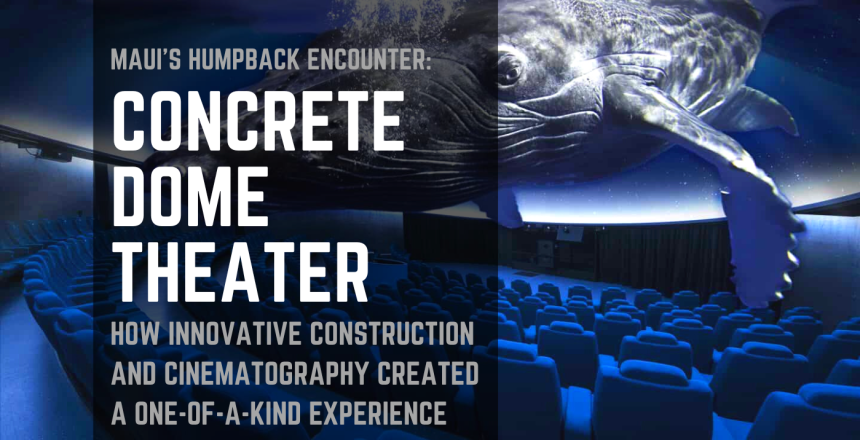Not everyone has the chance to swim with humpback whales. But in a Maui-based exhibit, it’s now possible to experience the feeling of being in the water with these incredible creatures. And it’s thanks in large part to a few dreamers and a bright-white concrete dome theater.
A Cutting Edge Experience in a Concrete Dome Theater
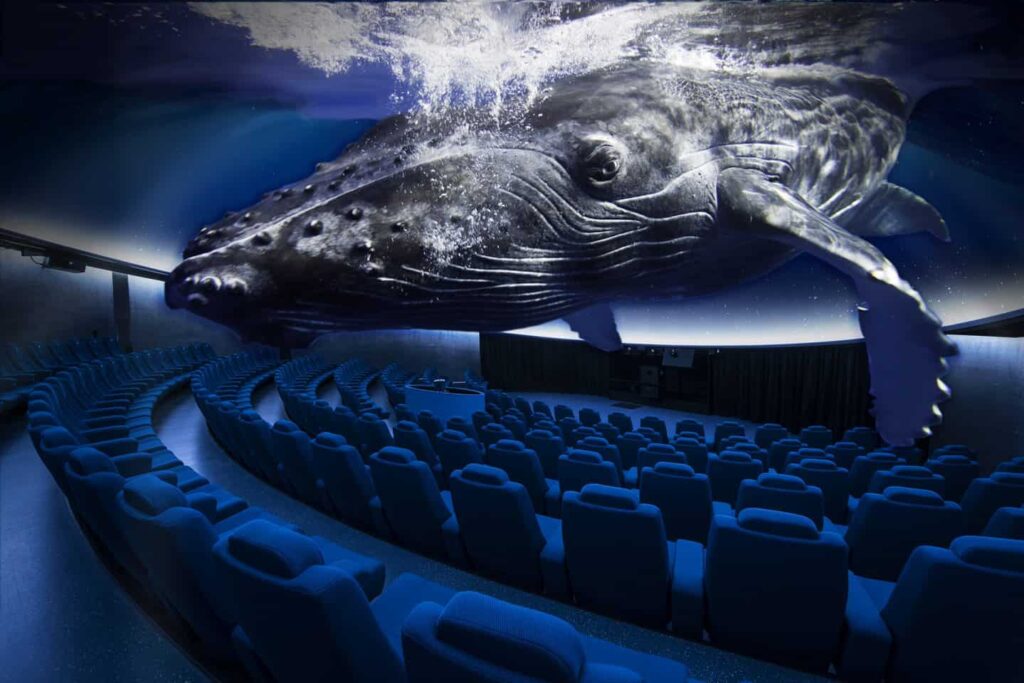
The Maui Ocean Center is considered one of the best aquariums in the world. In 2019, they opened the Humpbacks of Hawaii exhibit, and they’ve welcomed over 1 million visitors into the deep waters along Hawaii’s islands through an immersive experience like no other.
The concrete dome theatre offers a full 360-degree view of cutting-edge film and computer-enhanced imagery that brings the Hawaiian humpbacks to life in lifesize 3D projections. And the result is life-changing, according to the people who designed this exhibit.
Selling the Idea
When Maui Ocean Center started planning an exhibit that could bring the beauty of their native humpback population to land, they knew they needed something spectacular.
The exhibit’s designer, Chris Masterson, was convinced of this by the filmmaker behind the stunning Humpbacks of Hawaii experience that it needed to be life-changing in every way.
More than an Exhibit
Filmmaker Daniel Opitz created the Humpbacks of Hawaii with the purpose of creating “an emotional impact” for the visitors.
“I want to create an awareness that there is something stunningly beautiful out there. I want the viewer to understand how big, how beautiful, how powerful these creatures are.”
This is the vision Opitz brought to Maui Ocean Center general manager Tapani Vuori.
Life-Changing Experiences
As conservation efforts discourage interactions in the wild, opportunities to encounter humpback whales will decrease. It’s good for the environment, but increasing the distance between us and the creatures we hope to save isn’t always beneficial.
The vision behind the Humpbacks of Hawaii Encounter is to bring those interactions out of the water so that we can continue to support conservation efforts while still experiencing these incredible animals in real, meaningful ways. This is where efforts to build the massive concrete dome theater and interactive exhibit started.
And the result does not disappoint.
Making the Dream Into Reality
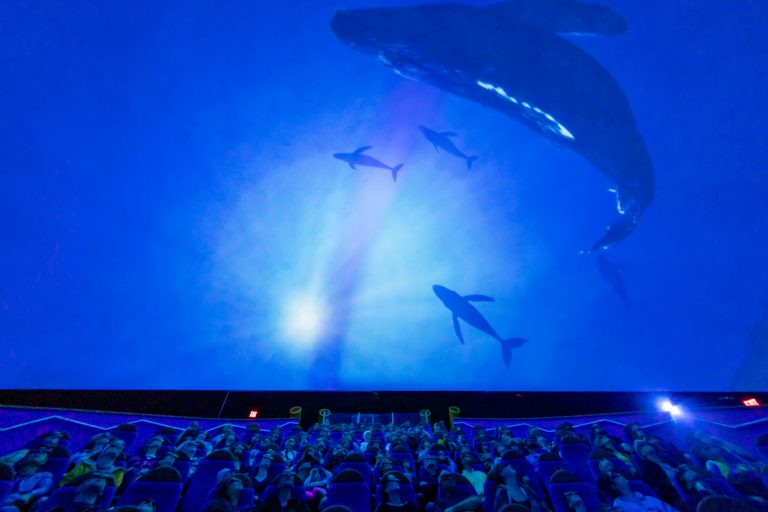
With a 58-foot concrete dome at its center, the exhibit offers a visual, tactile, and sensory encounter with the culture, nature, and beauty of these majestic creatures, called kohola in Hawaiian.
In fact, every inch of the exhibit points to these whales in some way: from the sounds and smells that surround visitors to the visual impact of 4K projections that come to life in the 118-seat dome theater.
Building the Dome Theater
Maui Ocean Center, along with Fabriozo Medozi of Pacific Atelier International, broke ground on the project in 2017, with the grand opening in 2019. But the dome itself only took about a year to complete. Throughout the process, the Maui Ocean Center kept its finger on the pulse of the community to ensure the finished project would fit in with its surroundings and community. And when the project was opened, those efforts paid off as the community rallied around the project, including a grand opening with traditional Hawaiian blessings.
The construction followed the same steps as other similar concrete domes, with an airform providing the shape prior to applying spray foam to the interior. From there, rebar was added to support the shotcrete that finishes the construction process.
The familiar four-step process, though, provided a completely innovative solution for the experience.
“Normally you have a sphere that gets cut in half and put on the ground and 10 people sit on the ground on the flat surface,” says Vuori in a 2019 interview with news outlet Maui Now. “Here, we’ve taken the sphere, we’ve cut 1/3rd of it off so the walls are concave below the horizon, and we have elevated the seats so they’re actually physically immersed in the space.”
That means that instead of just feeling like a projected video, the audience is quite literally in the middle of the action. The raked seating provides unobstructed views, giving an even more realistic effect to the 3D short film.
Filming the Humpbacks
In conjunction with NOAA, Opitz filmed Maui’s own segment of humpbacks over the course of two seasons. The camera crew captured family pods from below and above, which translated into viewers having the chance to feel submerged with them, not just viewing the whales from a distance.
Even the sounds throughout the building came from these local whales, including what Opitz says was the “last whale of the season” singing off of Ka‘anapali.
Groundbreaking Post-Production
Opitz has created award-winning work in the past, and this particular project is no exception. After two years of filming, he spent a full year to format the film for 3D projection.
Opitz states, “Everything seen is 100 percent real, but it went through a one-year post-production recreating the real image in order to get it in here. With regular footage, no matter what you would have tried, it would be technically impossible. So that was the insanity behind it.”
Every single part of the imagery underwent painstaking modeling to make it pop off the screen.
“What we did was use the real image, the real footage, and recreated the reality by turning them into 3D models including texture, the particles in the water, everything.”
And because of that attention to detail, visitors find themselves dodging the projected flukes of these whales while reaching out to touch them. That realistic experience, including actual-size projection, is an experience like no other in the world.
Designing the Dome Projection
The concrete dome theater provided a perfect canvas for the images Opitz had designed, but it took work to get the projection correct. The 4-by-4K resolution, along with Dolby Digital 7.1 surround sound, needed to fit the dome perfectly.
The design used two digital projectors to achieve the effect the exhibit needed. With a 180-degree vertical projection field and a 360-degree horizontal field, the 25-foot screen was tilted 17 degrees so that nothing would interfere with the film.
And since they chose not to cut the dome at its equator, the projection actually goes below the seats. There’s no barrier between the viewer and the projection itself. Opitz’s vision for an emotional experience that leaves viewers forever changed was not only possible, but it was also a reality.
The Experience Within
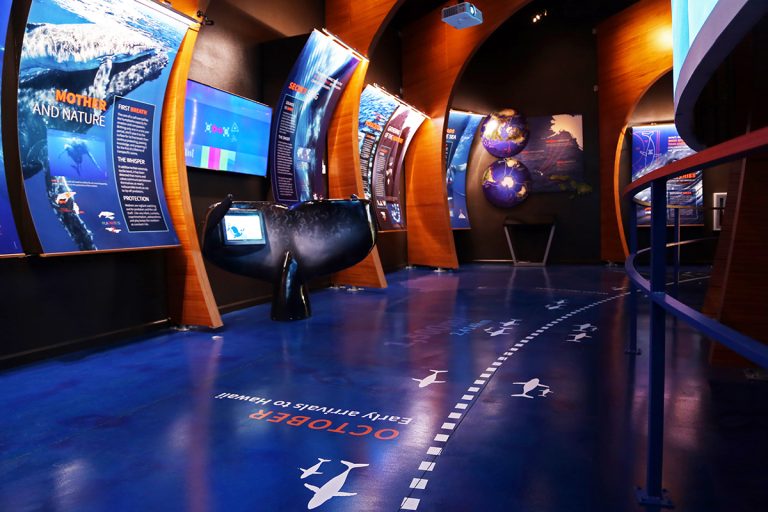
But the movie is only part of the Humpbacks of Hawaii Exhibit and Sphere. The whole experience hinges on bringing the scale and beauty of these creatures to life in unexpected ways.
The Building
Along the side of the central sphere, the exhibit has a 60-foot hall that houses several interactive exhibits that help paint a picture of humpbacks in amazing detail. But there’s something about the building that might not be obvious upon entering.
The size of the building, along with the gorgeous sandalwood arches that stretch from side to side the whole length of the room, are the same size and scale of a full-grown adult female humpback. This subtle detail was intentional, according to general director Chris Masterson.
“We are not trying to be blatant. We don’t want to give you the impression you have been swallowed by a whale here.”
Although the center had the opportunity to use a real humpback skeleton in the exhibit, the native Hawaiian community advised against it. The whale is considered sacred, so doing so would not always be seen in a positive light. The use of sandalwood arches in its place made it possible to be sensitive to cultural symbolism without losing the purpose of the design.
The Exhibits
Each exhibit focuses on a different aspect of the humpback whale, from its magnitude to its life cycle. Children can make whale songs on a special keyboard, while an interactive globe provides real-time location information for the pods of whales throughout the world. In the context of the building itself, the exhibits play into a design that Masterson outlines with excitement.
“Our intent is to architecturally do two things: One, give people the perspective of how big these creatures are in a very subtle way. And two, the whole story goes from macro to micro – we start with global populations and talk about the 14 different humpback segments around the world, we talk about the regional migration, and then the floor.”
That floor shows a map with an important educational purpose.
“This whole floor is an actual migration map that you walk from the feeding areas in Alaska, then to Hawai‘i. You get perspective of the distance they go—6,000 miles.”
Every element of the exhibit leads to one concept: immersing visitors in the full experience of swimming with humpback whales.
Full Immersion
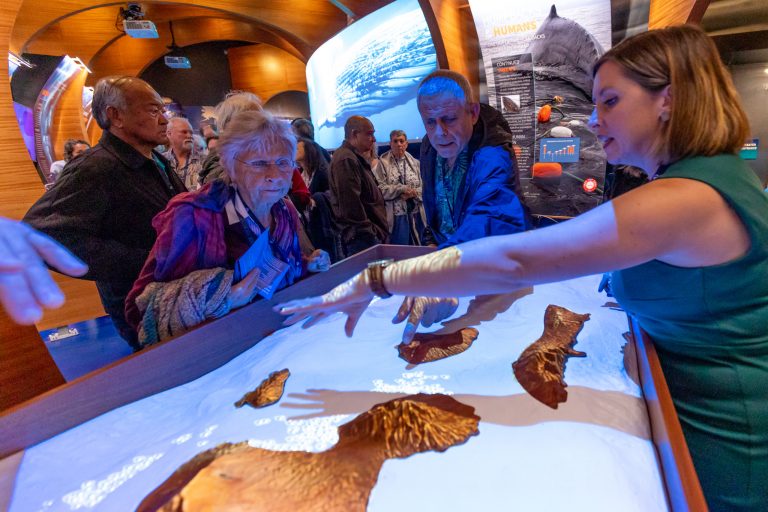
The building allows you to walk into the frame of a full-grown whale. The floor shows the path these amazing creatures traverse throughout the year. And the sounds of the whale songs surround visitors from start to finish. Visitors even experience smells that are deeply connected to humpbacks.
Sandalwood, or ‘iliahe in Hawaiian, is just as sacred as the humpback. Sandalwood is the protector of the whale in native culture, so using the fragrant wood made it possible to tie in another sensory experience that further immerses visitors in the exhibits.
From the exhibits to the concrete dome theater experience, every piece of Humpbacks of Hawaii is designed to bring to life the whales we still know so little about. And the final piece, the 13-minute film, is the most visceral experience of all.
Unbelievably Lifelike
So what does it feel like to experience this revolutionary film? From what visitors both say and do, the film makes it feel like you’re deep in the water below a pod of humpbacks. So much so that people reach to touch the fins and dodge the flukes throughout.
“I’ve heard comments like ‘spiritual’ and ‘awesome,’ and someone actually mentioned they nearly cried when experiencing it,” Vuori states.
What’s the Next Concrete Dome Innovation?
Opitz had originally pitched 6 ideas to Maui Ocean Center, from which they chose the humpback whale as the first focal point. The next step, he says, will be taking a deep look at the creatures that make up the main diet of humpbacks.
“We are currently already talking about a follow-up, which is going to be about the vertical migration of plankton. We go from very big to very small, which I totally love because they’re both connected to each other—those creatures are feeding from those small ones.”
There’s a clear benefit to using a concrete dome theater in place of conventional projection screens, but what about the dome itself? What’s the next innovation waiting in the wings?
Concrete domes offer unique qualities that can’t be replicated through stick construction. And as the technology behind, and connected to, concrete dome construction progresses, so will the applications of these incredibly strong and beautiful structures.
If you’re dreaming of a new and innovative project, consider what a concrete dome could provide:
- Unobstructed interiors, a literal blank canvas for any purpose
- Near-indestructible construction
- Sustainable and eco-friendly facilities
- Unique and eye-catching architectural features
Kingdome Builders is ready to partner with you to bring your dream to life. Contact us today to learn more about domes, and even schedule a tour of our on-site mini dome home.

